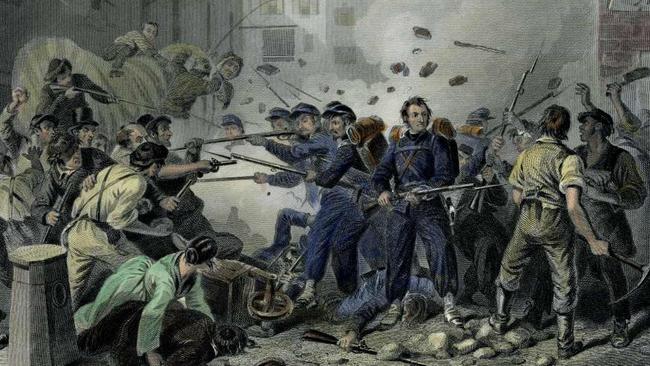A city long divided along faultlines of race tension
The riots in Baltimore following the death of a black man in custody have echoes through its often divided past.

Today in History
Don't miss out on the headlines from Today in History. Followed categories will be added to My News.
A state of emergency has been declared in Baltimore after riots erupted following the funeral of a black man who died in police custody.
Such violence is nothing new to the largest city in the State of Maryland. The riots are the latest example of seething racial tensions in the city that date back to the 19th century. As the population centre of Maryland, a state infamous for wavering in its allegiances during the US Civil War, it would later become a leader in the civil rights movement.
In the early 1800s Maryland was leaving behind its dependence on slave labour and drawing ex-slaves from across the country. While many were on route to other places via the Underground Railroad that helped runaway slaves escape to freedom, thousands remained in Baltimore. Even though Maryland did not abolish slavery before the Civil War, the city grew to have more free blacks than slaves and the largest community of free African Americans in the US.
A towering figure among these was Frederick Douglass (1818-95) who had secretly taught himself to read and write because of laws against teaching slaves. He had escaped slavery, running away from his masters in Baltimore, and became a noted antislavery campaigner, purchasing his freedom and going on to be an adviser to president Abraham Lincoln and an ambassador to Haiti.
But many Baltimore blacks remained in slavery or poverty. In the lead-up to the Civil War many of the city’s slave-owning citizens supported the southern states threatening to secede partly over the fear the federal government would abolish slavery.
In 1861, members of the Massachusetts militia marching through the city on their way to Washington to serve in the Union army, were attacked by a group of Baltimoreans sympathetic to the Confederate cause. Forced to defend themselves against rocks, sticks and even pistols, the troops fired on the crowd and a riot ensued. Four soldiers and 12 anti-war protesters were killed. Federal troops occupied the city during the war.
Lincoln’s emancipation of the slaves during the war resulted in more social dislocation and racial tensions in the city. Baltimore was slow to recover from the economic effects of the war and work was scarce for blacks, who were widely discriminated against in the workforce, leading to protests and strikes.
Maryland refused to ratify the 15th Amendment to the constitution, allowing blacks to vote, and over the decades after the end of the Civil War white citizens worked to push the blacks into segregated parts of the city.
As the population of the city grew in the early 20th century it became harder to have distinct separation of whites and blacks, particularly in high-density areas such as apartment blocks. In 1910 Baltimore became the first US city to pass a law demanding strict segregation of apartments.
The white population swelled during WWII, leaving African Americans feeling more marginalised than ever. But Baltimore’s blacks were finding a voice to protest segregation and discrimination.
One of the earliest campaigns for equality began in 1946 when blacks from the National Association for the Advancement of Colored People (NAACP) joined with whites from the Inter-racial Fellowship Youth to protest admission policies at Ford’s Theatre in Baltimore, where blacks could only sit in the balcony. It took seven years of picketing, attracting some big name stars including singer Paul Robeson, before the policy was finally changed.
In the 1950s Baltimore was forced to desegregate its public schools and the NAACP played a role in preventing attempts by the Maryland State Department of Education to wind back the desegregation. In the 1960s Baltimore staged one of the first sit-ins at a local drugstore, where black students sat in a segregated drugstore and refused to move until the store changed its policy. It sparked a wave of desegregation.
Some residents refused to conform to the changes. When teenage dance show host Buddy Deane, told his dancers he wanted to bring in black dancers (normally segregated to their own “Negro Day” every other Friday) to dance with the whites, most of the teens said their parents wouldn’t permit it. The show was pulled off the air for refusing to integrate. The incident later inspired the film and stage musical Hairspray.
Many Baltimore blacks drew inspiration from civil rights leader Martin Luther King, a preacher who had led marches across the country. When he was murdered in 1968 there were riots across Baltimore, with scenes of looting, violence and arson that are echoed in the current riots.



